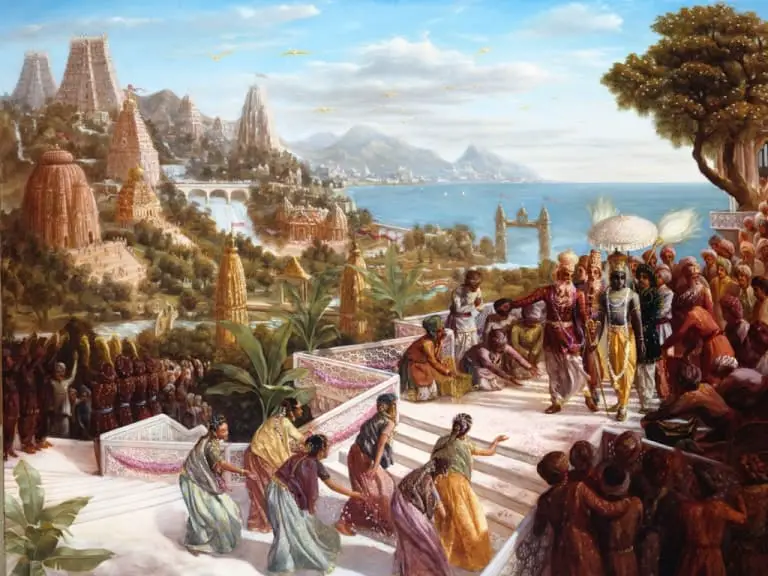
The underwater ruins of Dwarka make up one of the greatest archaeological mysteries of all time.
Nobody knows what happened there or how old the site is. The place is a stuff of legend, but in this article, I’ll give you a summary of the recent archaeological findings that challenge the mainstream view of history. In short, there are reasons to suspect that the legendary city of Lord Krishna was real.

1. Dwarka (or Dvaraka) – The Ancient City of Northwestern India
The holy city of Dwarka is based in the state of Gujarat on the shores of the Arabian Sea and has a population of about 39,000. According to Mahabharata, the ancient Indian epic, it was established by Lord Krishna himself. The present town is understood to be the seventh one in the same place (this is partially confirmed by layers of ruins found underground). Dvārakā (‘Gateway to Heaven’) is one of the Sapta Puri (seven sacred cities) of Hinduism, and it is a goal of Tirtha (pilgrimage) for thousands of Hindus every year. Right now it looks like a simple fishing village, but it might have had a glorious past.
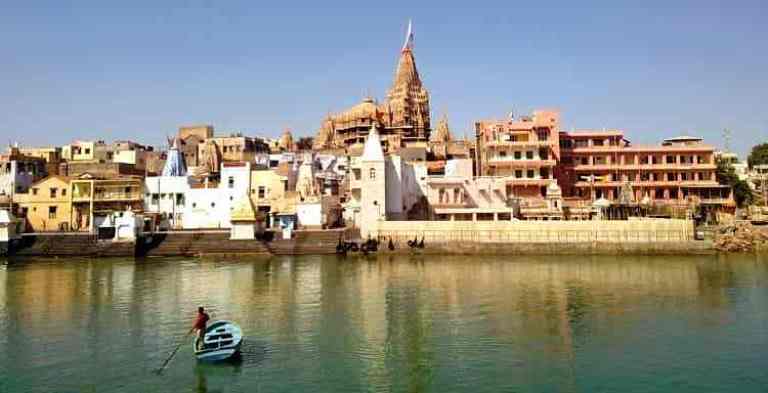
2. The Legends of Dwarka
There are numerous legends about the city. The most prominent one is found in the ancient epic of Mahabharata. It is well established that the events described in the epic took place around 3100 BCE. After defeating and killing his uncle Kansa, Krishna decided to migrate with his people from Mathura to Dwarka to establish a new city (according to the legend, he “reclaimed” 96 square kilometers of land from the sea to do it). It is said that to build the city, Krishna summoned Vishwakarma, the architect of demigods who supposedly constructed Dwarka in one day.
3. Dvārakā according to Harivamsa and Puranas
According to the Harivamsa, one of the most important works of Sanskrit literature, Dwarka was built on “submerged land”, “released by the ocean”. It was squared “like a chessboard”. It was guarded by four main gates and the city’s houses were arranged in lines. The city had “high buildings”, “made in gold”, which “almost touched the sky” and “could be seen everywhere like clouds”. Moreover, the city is also mentioned in Bhagvat Puraan, Skanda Puraan, and the Vishnu Puraan (Puranas are ancient Indian legends, histories, and myths).
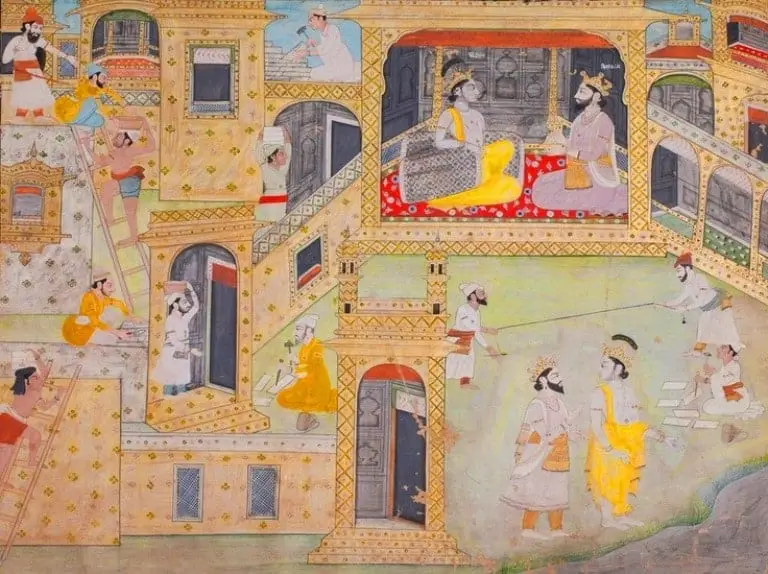
4. Dvārakā according to Mahabharata
In Mahabharata, we find many detailed descriptions of the old, glorious city. Here’s an excerpt from the Wikipedia page about Dvārakā:
The City was filled with the sounds of birds and bees flying about the parks and pleasure gardens, while its lakes, crowded with blooming individua, ambhoja, Kahlua, kimura, and utpala lotuses, resounded with the calls of swans and cranes. Dvaraka boasted 900,000 royal palaces, all constructed with crystal and silver and splendorously decorated with huge emeralds. Inside these palaces, the furnishings were bedecked with gold and jewels. Traffic moved along a well-laid-out system of boulevards, roads, intersections, and marketplaces, and many assembly houses and temples of demigods graced the charming city. The roads, courtyards, commercial streets, and residential patios were all sprinkled with water and shaded from the sun’s heat by banners waving from flagpoles.
This is, of course, an exaggeration but if the site contained even one-tenth of this splendor, we would say it was a groundbreaking discovery of archeology. There’s no evidence for these great palaces on the surface of the earth, but that’s not where we should be looking.
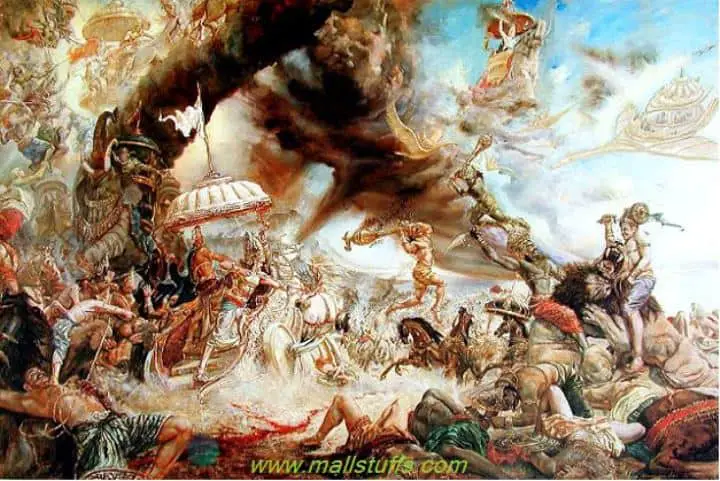
5. The high-tech battle between Shalva and Krishna
There are many events connected to Dwarka (mentioned especially in Mahabharata) and they give us a strong indication that it might have been a civilizational center. One of the most interesting legends deals with the war between Lord Krishna, and King Shalva who mercilessly besieged Dwarka. In Bhavagata Purana, we find that Shalva was equipped with a Vimana (a flying machine) and that:
“He besieged the city with a large army, O best of the Bharatas, decimating the outlying parks and gardens, the mansions along with their observatories, towering gateways and surrounding walls, and also the public recreational areas”. “From his excellent vimana he threw down a torrent of projectiles . . . A fierce vortex arose and blanketed the entire area with billowing dust.”— Bhavagata Purana (10.76)

Then finally Krishna responded by discharging his missile, described as being “bright as the sun in the sky” which ultimately destroyed Shalva and his army. Whether there’s any truth to this supposedly marvelous technology used by the opponents, we could assume that the battle took place and a lot of damage was caused.
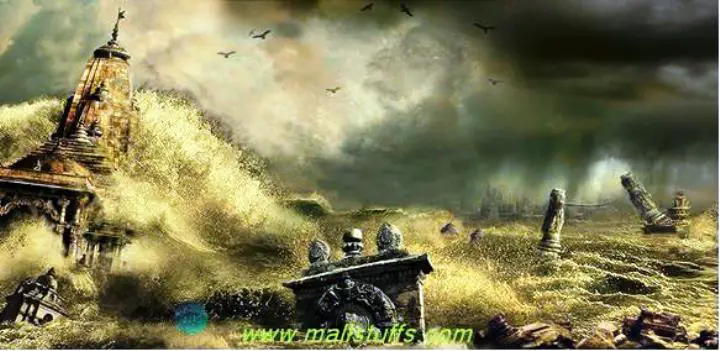
6. The great city of Dvārakā submerged by the sea
According to Mahabharata, after the Kurukshetra war (during which the high-tech battle took place) the city was flooded and submerged by the Arabian Sea. Here’s an account of Arjuna, the most famous of Krishna disciples:
“The sea, which has been beating against the shores, suddenly broke the boundary that was imposed on it by nature. It rushed into the city, coursing through the beautiful city streets, and covered up everything in the city. I saw the beautiful buildings becoming submerged one by one. In a matter of a few moments, it was all over. The sea had now become as placid as a lake. There was no trace of the city. Dwaraka was just a name; just a memory…”
This supposedly happened after Krishna left the earth for Vaikuntha (Place of no Hindrance), about 36 years after the Mahabharat War (3090 BC), and when the major Yadava leaders were killed in disputes among themselves. The Vishnu Purana also mentions the submersion of Dwarka, stating:
On the same day that Krishna departed from the earth the powerful dark-bodied Kali Age (Age of Vice) descended. The oceans rose and submerged the whole of Dwarka.

7. By why would that happen? Why would the city be flooded and destroyed?
According to Mahabharata, the city had to submerge because of Queen Gandhari’s curse on Lord Krishna (her 99 sons died during the war and she blamed Krishna for not stopping the slaughter). Then:
A small feud started among the Yadavas and it evolved into a massive fight. This fight killed all the sons of Lord Krishna and his elder brother. Almost all of the Yadavas were killed and the city was burnt to ashes. Krishna and his brother fled to the forests without stopping the fight. Later in the forest Krishna was struck by an arrow, mistaken for a deer, by a hunter who was King Baali of the Ramayana period in his rebirth. Later, the city submerged into the sea.
For hundreds of years, there was no evidence suggesting that any of the legends may be true and that there was ever a beautiful city as described in the epic. But things started to change at the beginning of the 20th century.
8. The archaeological findings at the Dwarka site

9. The ruins around Bet Dwarka
The first thing to be excavated was the ruins around the island of Bet Dwarka, around 30 km north of Dwarka. The works began in the 1930s but soon stopped. The next exploration was carried out in 1969-1970 and yielded varied results. The last one was undertaken in 2007, and it recorded several findings dated to around 1528 BCE – the period of the Late Harrapan Civilization. The archeological site is far from being fully explored, but interestingly, it is said that:
Krishna conducted the administration of his kingdom from Dwarka while residing with his family in Bet Dwarka.
10. The layers of temples underneath the current city of Dwarka
One of the main players involved in solving the mystery of the ancient city was Dr. S.R. Rao. He and his team undertook an extensive search of this city along the coast from 1984-88 and finally succeeded in finding the submerged city off the Gujarat coast.

Between 1983 and 1990, the well-fortified township of Dwaraka was discovered, extending more than half a mile from the shore. In his work, The Lost City of Dwaraka, Dr. Rao has given scientific details of these discoveries and artifacts. Here is a great documentary about Dwarka, featuring Dr. S.R. Rao. In it, you will find more about the ruins buried underneath the city. In this documentary, at around 14:45 you will see where exactly Dr. S.R. Rao was searching for underwater ruins of Dwarka. Dr. Rao said that they planned to explore a site around 10km further to the northwest of the actual site. Unfortunately, he encountered problems with funding and died in 2013 which practically stopped the excavations.
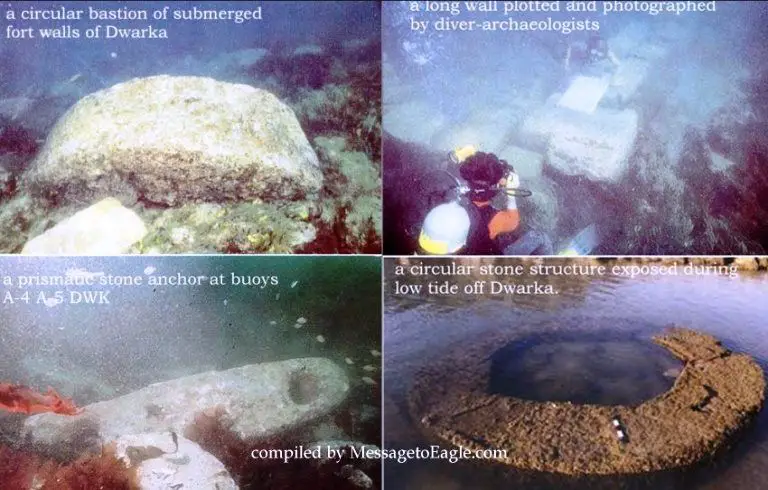
11. The historicity of Dwarka
Dr. Narahari Achar checked the references to the lunar eclipses and asteroids mentioned in Mahabharata – especially with the connection to the war. By using his special software, he concluded that the war started on November 6th, 3126 BCE. Some archeologists think that it was around that time that Krishna’s Dwarka existed. 3000 BC the sea levels were 10 m lower so that would explain the submergence of the city.
12. The artifacts found at the Dwarka site
The pottery they’ve found (and analyzed through thermoluminescence) was dated at 3520 BC for period one, and 2000 BC for period 2. That’s another piece of evidence that corroborates the story from Mahabharata. When you look at the underwater photos, you can see a couple of stones and walls. But if the city existed 5000 years ago, then the remains must be buried deep under the sediment and sand. Additionally, they don’t know if it’s the main spot because it looks more like a port, not a city.
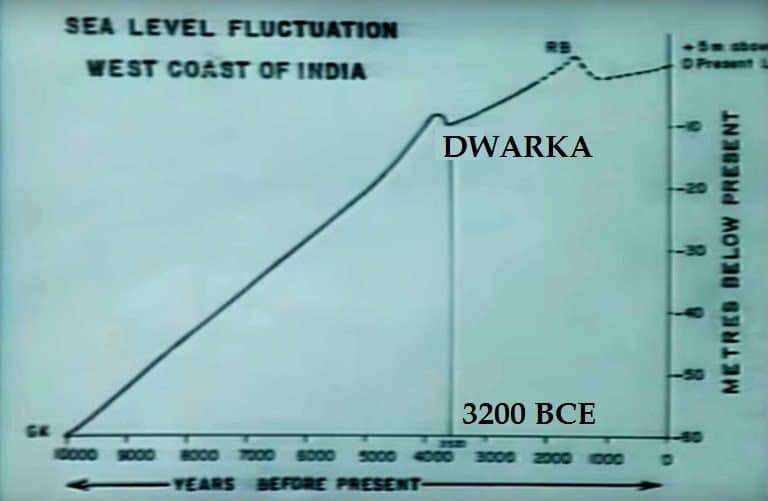
13. The stone anchors around the city of Dwarka
Marine archeologists found stone anchors similar to ones used in Syria and Cyprus (1400 – 1200 BC) and it’s been proven that the trade existed between these lands as far back as 2000 BC. The other anchors they’ve found date as far back as 2500 BC. Here’s an excerpt from an article about the anchors:
A large number of stone anchors were discovered in a water depth of 10–14 m off Dwarka during the 1998–1999 seasons. The seabed near the anchors consists of a ledge with an average height of 1 m. Several anchors were found trapped between the rocks suggesting an anchorage. Twenty stone anchors of three types were located in a submerged channel on the southern side of the site. The grapnel type of anchor is associated with Indo-Arab trade between the 8th and 16th centuries AD. The triangular or composite anchors have a date ranging from 2500 BC to the Modern Period. Therefore, the dating of these anchors at Dwarka is a matter of concern and is discussed.
So if the actual Dwaraka existed 3200 years BCE, then maybe the site 9 km from shore is just a prelude – a younger site or a port. It would be good to scan how exactly the sea level looked at around 3000 BC to check what lands were available at that time and search there. 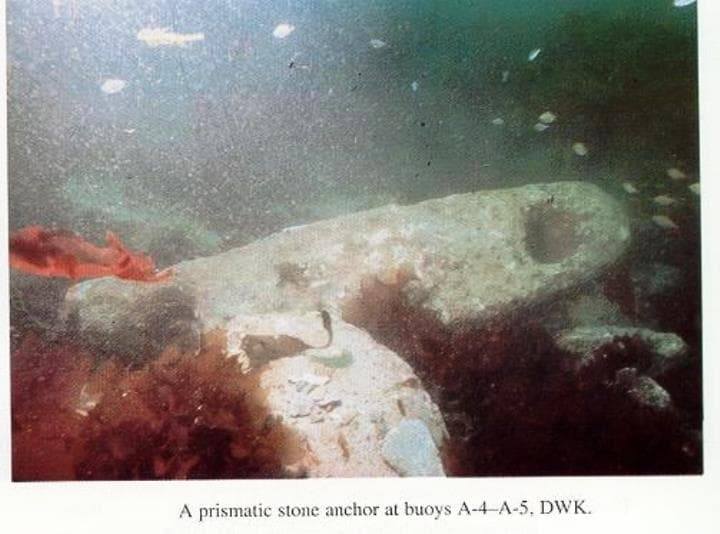
14. Marine archaeology in the Gulf of Khambhat (Cambay) – there’s more to be discovered
In 2001, a follow-up investigation was conducted by NIOT (National Institute of Ocean Technology). Among other things, they’ve found a piece of wood, pottery sherds, weathered stones initially described as hand tools, fossilized bones, and a tooth. After sending the findings to many different laboratories (including in Germany) they dated the piece of wood to the age of 9,500 years old. Of course, this is not conclusive evidence because at that time, the terrain was rich in forests and that might be just a random piece of wood.
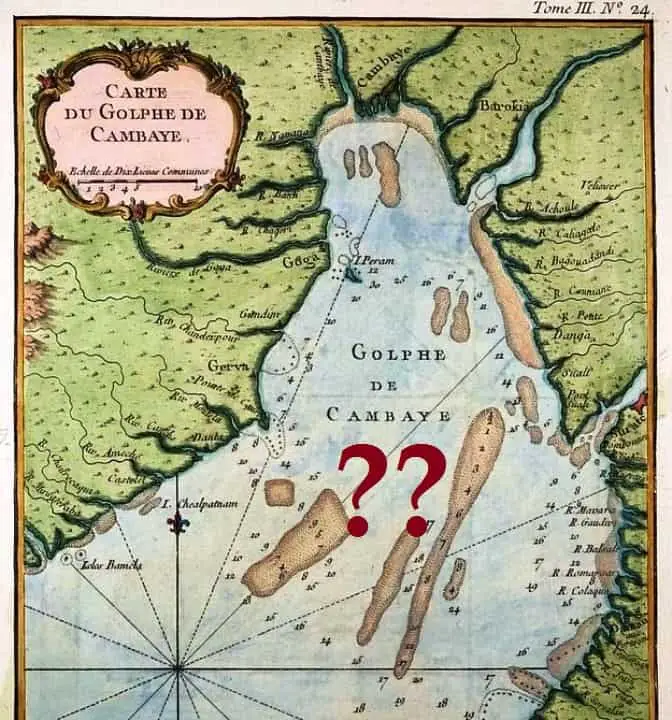
But in 2002 and 2003 NIOT returned to the site to find two paleo-channels flanked by rectangular and square basement-like features. Here’s an excerpt from an article about the most recent studies conducted from October 2003 to January 2004 (mainly a geologic study):
Techniques used during this investigation include a bathymetry survey, sub-bottom survey, side-scan survey, and magnetic survey. One of the major findings from this investigation concerns the orientation of sand ripples at the site. NIOT researchers claim that there are two sets of ripples visible at the site; one set is a natural feature formed by tidal currents while the other set has formed about underlying structural features.
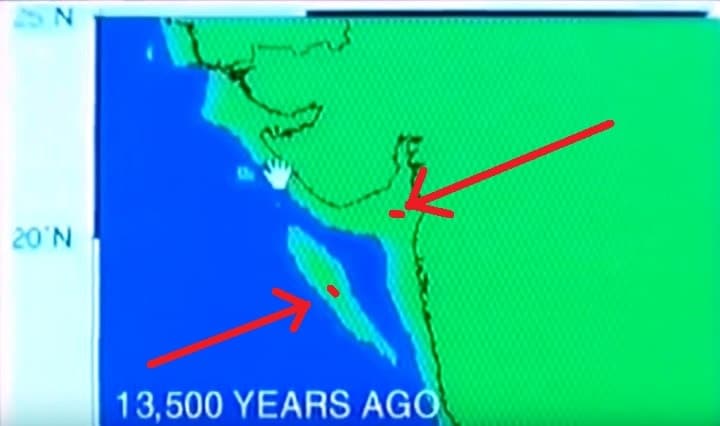
15. The “Other” Dwarka Site (possibly much older than the city of Lord Krishna)
Dr. Badrinarayanan and Murli Manohar Joshi of NIOT spotted something more than the original underwater ruins 40 meters deep, and 9km away from the shores of Dwarka. Just by accident, they found new structures while monitoring the seafloor for pollution. This time the structures lay underwater in the Gulf of Cambay. Here’s an excerpt from an article about the topic:
The buildings are evenly spaced and contain deep foundations within the seabed; several regular steps seem apparent within a number of the structures. A feature called the “fortress” is nearly 98 meters in length (321 feet). Joshi also calls to attention other buildings underwater, including a granary, drainage system, and public bath. There can be no doubt that the features are man-made. Computer-simulated underwater image of sonar-scanned “fortress” at the Gulf of Khambat off the coast of the Gujerat Peninsula 131 feet below the water surface.
16. The new paradigm of history
Except for ancient pottery, they also discovered ceramic plates that contain eroded “impressions”. This might be the evidence of some of the first writing in the world. If the site is situated 131 feet below the surface of the water, it puts the site at the end of the Second Ice Age (almost 13,000 years ago). This completely shatters our present view of history where civilization was supposed to begin around 3500 BCE in the Middle East and Egypt. Moreover, a huge “U” shaped structure has been found on the coast of Bengal, and looking at the sea-level data, we could conclude that it’s over 10,000 years old. That’s another thing that validates the flood myths existing all around the world but is presently denied by archeologists. If you want to learn more about these underwater structures and their possible history, please watch this excellent documentary by Graham Hancock. At 7:13 you can see that around the end of the Second Ice Age, a huge amount of terrain was submerged. You can also see that at the Gulf of Cambay, there was a large island that disappeared around 7000 BC. Except for sonar scans, no one checked that site.
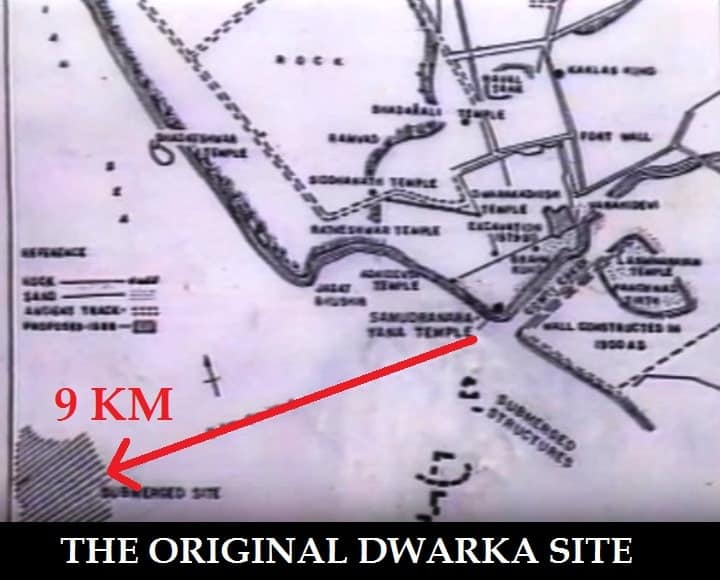
17. Why the research about the ancient city of Dwarka has stopped?
It’s quite surprising that with all the evidence piling up, nobody is interested in uncovering what happened to Dwarka. This might be because The Archeological Survey of India lacks proper funds which prevent it from completing the projects, which it undertakes. According to Aishik Saha:
There could be several reasons that the project was stopped. It is most likely that the gap is necessary to continue the study of the findings and look for corroborative evidence elsewhere.
Most of the archeological findings were taken to Vadodara a place managed by the Archeological Survey of India and Dr. K.C. Nauriyal. Also, there’s Prof. K. Krishnan from the University of M.S. Baroda who seems willing to support more work around the archeological sites connected to Dwarka. From the article about new findings in 2004:
As of today, the NIOT or any other agency has yet to conduct careful underwater marine archaeological digs of the site with manned dives. The legislation required to do so is complicated and requires on average much more funds than regular land-based digs and surveys. This is another reason why such places as Dwarka in other parts of the world’s inundated vast coastal ocean shelves remain unstudied and elusive to archaeologists.
Here you can read more about the reasons for stopping the excavation works around Dwarka. Also, if you want to learn more about Dwarka and why they stopped the works, please watch this interesting documentary by Amish Shah.
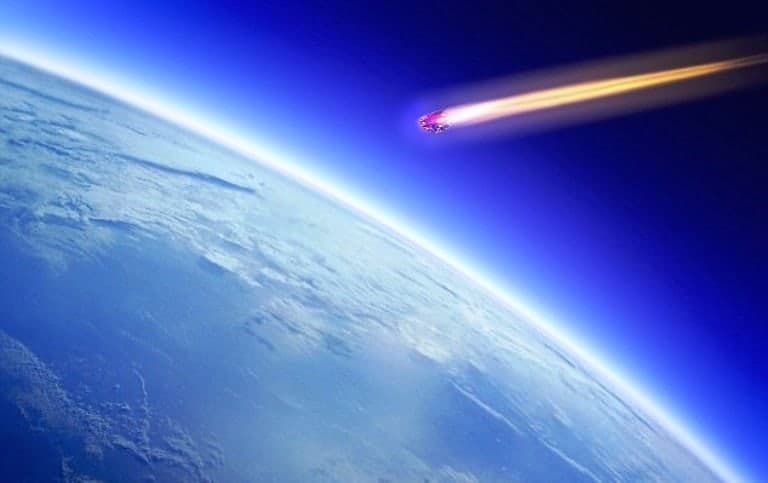
18. The speculations about what happened to Dwarka
Below, you will find a basic explanation of what might have happened to Dwarka. This theory is not fully corroborated, but it’s based on the evidence presented in this article: 1. There was an ancient city on the two islands in the current Gulf of Cambay and the nearby shores – dating more than 13,000 thousand years. 2. 12.600 years ago, there was a great cataclysm (two comets hit the Earth) which ended the Second Ice Age and caused tremendous tsunamis and a precipitous rise in sea levels. That led to the submergence of the presumably “first Dwaraka”, along with millions of square miles of land around the world. More on this in The Magicians of The Gods.
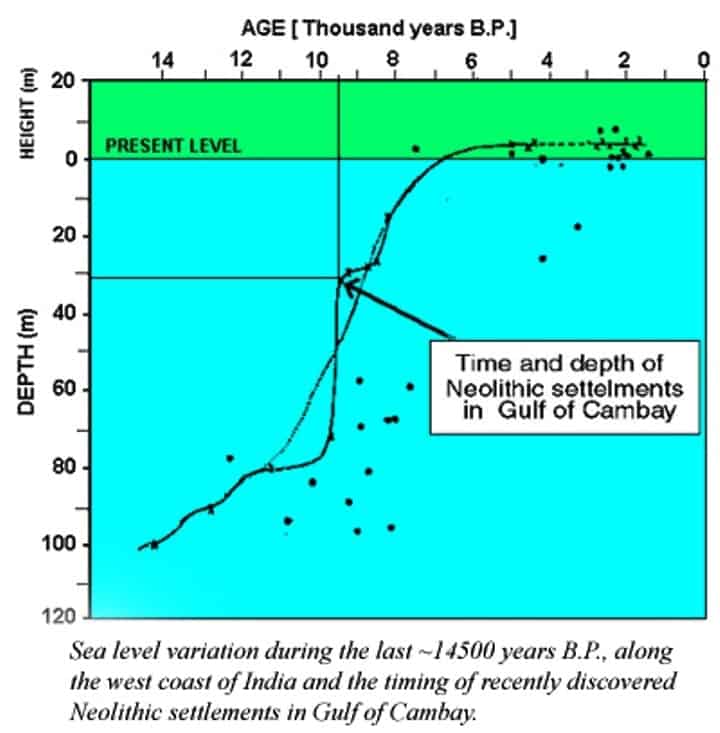
An excerpt from an article about sea levels around India:
The curve shows that 14,500 years ago, sea level along the west coast of India was about 100m lower as compared to the present, and rose to 80m depth around 12,500 years ago with a rate of ~10m/1,000 years. It was followed by a quiet period when the level remained unchanged for about 2,500 years, thus providing time for civilization to flourish before being engulfed by the sea again. From 10,000 to 7,000 years ago, the sea level rose at a very high rate (~20m/1000 years) and after approximately 7,000 years B.P. it has fluctuated to more or less the present level.
3. The survivors of the flood run to the north, to the mountains. Here, the legend of Manu (the First Man who rescued people from the flood and helped to rekindle the civilization) comes into play. It is also said that he was the carrier of the Vedas which he received from Matsya, one of the Avatars of Vishnu.
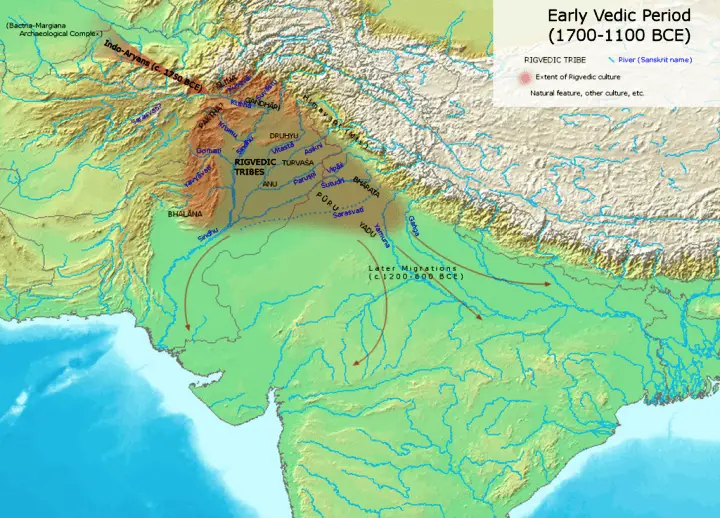
More about cities that suffered from the flood:
Besides Dwarka, there are mentions in the scriptures of many renowned cities which were washed away by the rivers on whose banks they were situated. Mahabharata mentions that Hastinapura was washed away by the Ganga and consequently the Pandavas had to migrate to Kaudambi. Similar was the case with Pataliputra which, even though the premier city of the land, later became the worst victim of inundation according to Dandin, the author of the Dashakumaracarita. Jain legends acknowledge the presence of the Metropolis of Dwarka as being close to the Girnar mountains. (Maybe that’s where people went during the flood).
4. In the north of India, we find traces of this ancient Rigvedic civilization. Later, the tribes started migrating to the south and formed a new civilization around the Sindhu and Sarasvati rivers (which led to the modern-day Dwarka). Sarasvati dried up around 4000 BCE, but in the past, it has been a grand river and it’s described as such in Mahabharata. 5. The city of Dwarka was gradually rebuilt, and that’s where the Mahabharata stories are coming from. (But the older city was probably already underwater).
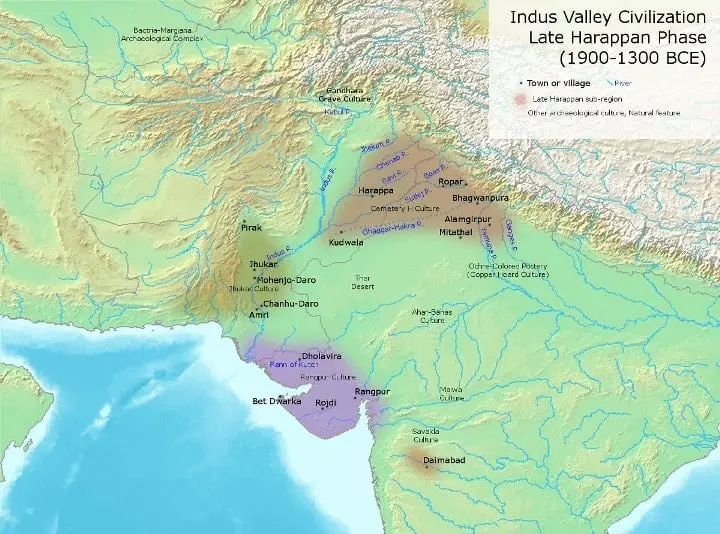
6. The city described in Mahabharata fell into ruin after the war and was gradually submerged by the rising sea levels. 7. The underwater ruins are based at the presently known site discovered by Dr. S.R. Rao, but there might be a much greater site around 10 km northwest of this site. There are also ruins of the oldest Dwarka, submerged in the Gulf of Cambay and waiting to be explored. This article is purely speculative, and in it, I tried to touch upon historical possibilities. But the major thing I wanted to accomplish was to urge you to share this information and make it widely available. We have to know what happened to Dwarka, as it has major importance for the understanding of human civilization. Please share! Next up, you may want to explore a guide to the top book publishing companies in India.
Hey there, welcome to my blog! I'm a full-time entrepreneur building two companies, a digital marketer, and a content creator with 10+ years of experience. I started RafalReyzer.com to provide you with great tools and strategies you can use to become a proficient digital marketer and achieve freedom through online creativity. My site is a one-stop shop for digital marketers, and content enthusiasts who want to be independent, earn more money, and create beautiful things. Explore my journey here, and don't forget to get in touch if you need help with digital marketing.

